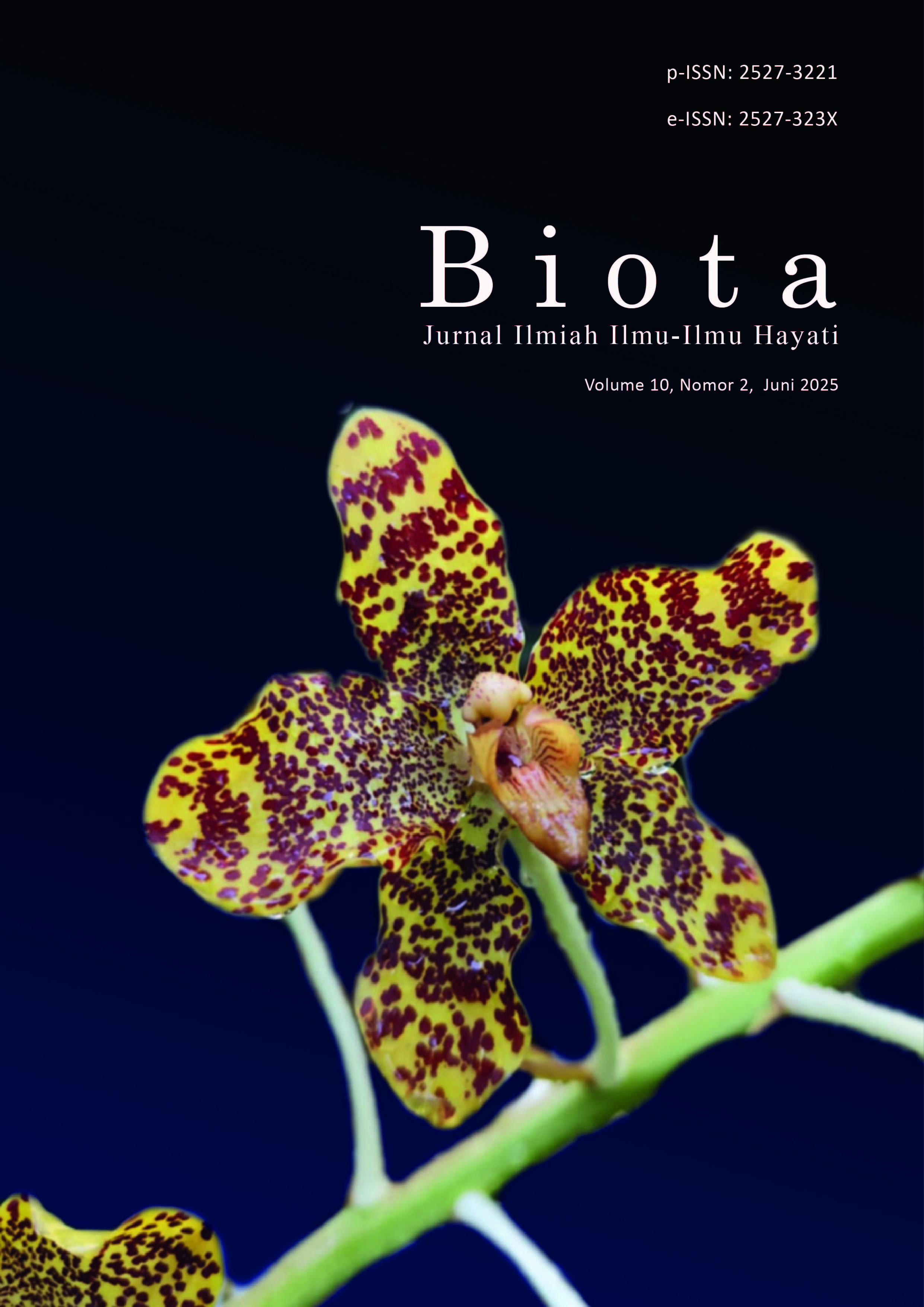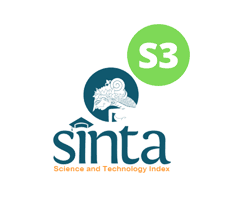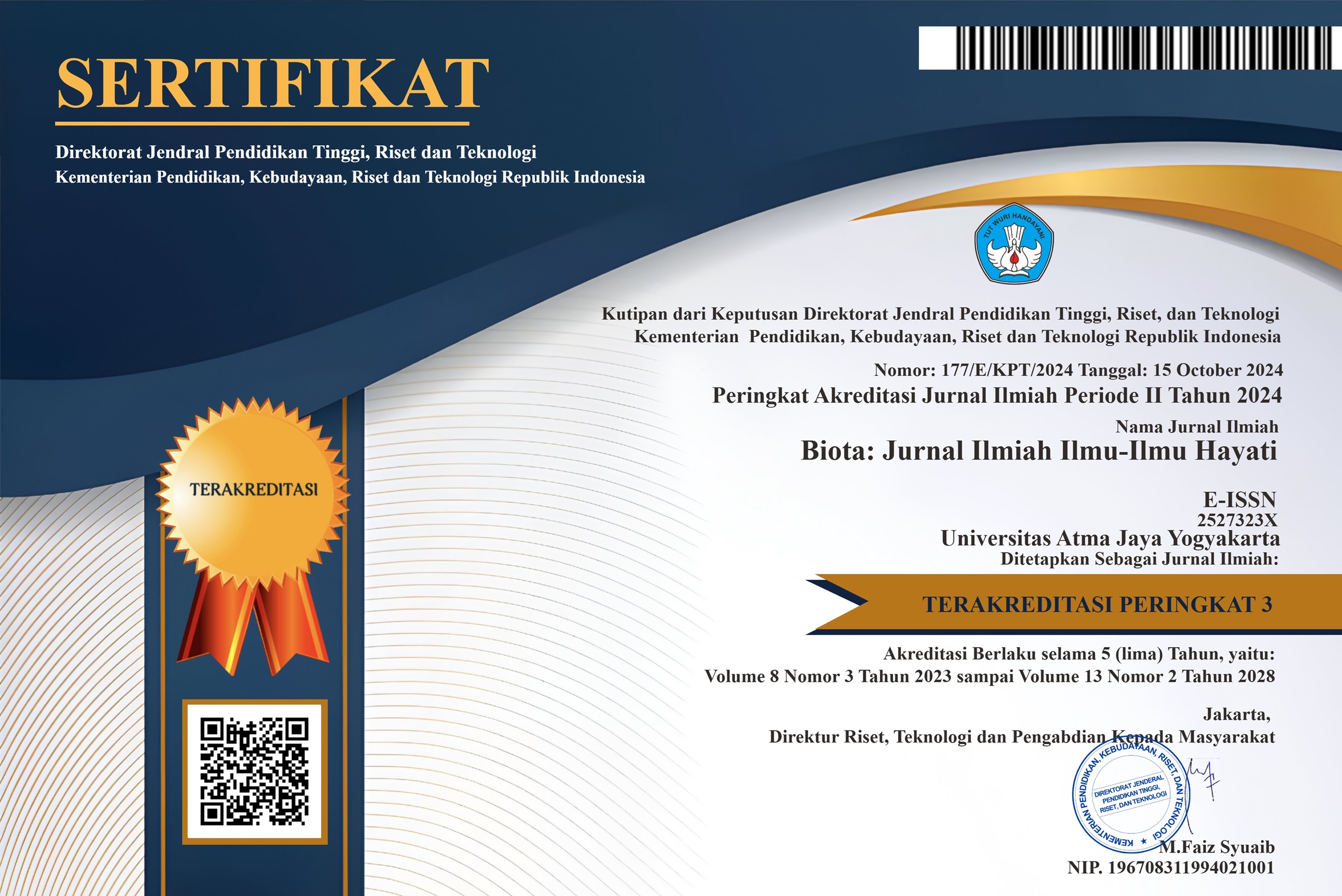Volatile Profiling of Root-Shoot and Fruits of Capsicum frutescens var. Salo Dua from Enrekang, Indonesia
DOI:
https://doi.org/10.24002/biota.v10i2.10003Keywords:
Capsicum frutescens, GC-MS, local plant, metabolite profiling, volatilesAbstract
Capsicum frutescens var. Salo Dua is a local variety cultivated in Enrekang Regency, South Sulawesi. It has unique traits of color transition during fruit ripening and extended post-harvest shelf life. However, the metabolite profiling in this potential variety has not been explored. This was an initial study that aimed to profile the volatile compounds in the root-shoot parts (as vegetative) and in the ripe fruits of Salo Dua variety. The instrument of Gas Chromatography coupled with Mass Spectrometry (GC-MS) was used to separate and characterize the volatile compounds. Our study revealed a higher number of forty-two volatiles in the ripe fruits compared to the twenty-eight volatiles in the shoot-root parts. The five major compositions of the chemical class in ripe fruits were characterized by the formation of alcohols (26%) followed by esters (19%), alkaloids (10%), fatty acids (10%), and ketones (7%). While the abundant volatiles in the root-shoot parts were shown by the presence of esters (29%), alcohols (21%), fatty acids (18%), alkaloids (11%), and heterocyclic (7%). There were nineteen volatiles that only emitted in the ripe fruits. Of which, capsaicin and dihydrocapsaicin were detected in the ripe fruits with an average relative area of 1% and 0.51%, subsequently.
References
Adepoju, A.O., Omotoso, I.O., Femi-Adepoju, A.G. & Karim, A.B. (2020). Comparative studies on the antimicrobial, chemical and biochemical contents of the foliar extracts of Capsicum fructescens L. varieties. African Journal of Biotechnology 19(12): 836-845.
Ahmad, R., Alqathama, A., Aldholmi, M., Riaz, M., Abdalla, A.N., Mostafa, A., Al-Said, H.M., Alqarni, A.M., Ullah, R., Asgher, S.S., Amir, M., Shaaban, H. & Ahmad, W. (2022). Gas Chromatography-Mass Spectrometry (GC-MS) metabolites profiling and biological activities of various Capsicum annum cultivars. Plants 11(8): 1022.
Alam, M.A., Syazwanie, N.F., Mahmod, N.H., Badaluddin, N.A., Mustafa, K. ‘Ain, Alias, N., Aslani, F. & Prodhan, M.A. (2018). Evaluation of antioxidant compounds, antioxidant activities and capsaicinoid compounds of Chili (Capsicum sp.) germplasms available in Malaysia. Journal of Applied Research on Medicinal and Aromatic Plants 9: 46-54.
Aranha, B.C., Hoffmann, J.F., Barbieri, R.L., Rombaldi, C.V. & Chaves, F.C. (2017). Untargeted Metabolomic Analysis of Capsicum spp. by GC–MS. Phytochemical Analysis 28(5): 439-447.
Ayariga, J., Abugri, D., Amrutha, B. & Villafane, R. (2022). Capsaicin potently blocks Salmonella typhimurium invasion of vero cells. Antibiotics 11(5): 666.
Baenas, N., Belović, M., Ilic, N., Moreno, D.A. & García-Viguera, C. (2019). Industrial use of pepper (Capsicum annum L.) derived products: Technological benefits and biological advantages. Food Chemistry 274: 872-885.
Barbero, G.F., Ruiz, A.G., Liazid, A., Palma, M., Vera, J.C. & Barroso, C.G. (2014). Evolution of total and individual capsaicinoids in peppers during ripening of the Cayenne pepper plant (Capsicum annuum L.). Food Chemistry 153: 200-206.
Barton, K.E. & Boege, K. (2017). Future directions in the ontogeny of plant defence: understanding the evolutionary causes and consequences. Ecology Letters 20: 403-411.
Begum, S.M.F.M., Priya, S., Sundararajan, R. & Hemalatha, S., (2017). Novel anticancerous compounds from Sargassum wightii: In silico and in vitro approaches to test the antiproliferative efficacy. Journal of Advanced Pharmacy Education and Research 7(3): 272-277.
Bracho-Nunez, A., Welter, S., Staudt, M. & Kesselmeier, J. (2011). Plant‐specific volatile organic compound emission rates from young and mature leaves of Mediterannean vegetation. Journal of Geophysical Research 116: D16304.
de Sá Mendes, N. & de Andrade Gonçalves, É.C.B. (2020). The role of bioactive components found in peppers. Trends in Food Science and Technology 99: 229-243.
Elshafie, H.S., De Martino, L., Formisano, C., Caputo, L., De Feo, V. & Camele, I. (2023). Chemical identification of secondary metabolites from rhizospheric Actinomycetes using LC-MS analysis: In silico antifungal evaluation and growth-promoting effects. Plants 12(9): 1869.
Gurnani, N., Gupta, M., Mehta, D. & Mehta, B.K. (2016). Chemical composition, total phenolic and flavonoid contents, and in vitro antimicrobial and antioxidant activities of crude extracts from red chilli seeds (Capsicum frutescens L.). Journal of Taibah University for Science 10(4): 462-470.
Isah, T. (2019). Stress and defense responses in plant secondary metabolites production. Biological research 52(1): 39.
Jarret, R.L., Levy, I.J., Potter, T.L. & Cermak, S.C. (2013). Seed oil and fatty acid composition in Capsicum spp. Journal of Food Composition and Analysis 30: 102-108.
Jeyadevi, R., Sivasudha, T., Ilavarasi, A. & Thajuddin, N. (2013). Chemical constituents and antimicrobial activity of Indian green leafy vegetable Cardiospermum halicacabum. Indian Journal of Microbiology 53: 208-213.
Lozada, D.N., Pulicherla, S.R. & Holguin, F.O. (2023). Widely targeted metabolomics reveals metabolite diversity in Jalapeño and Serrano chile peppers (Capsicum annuum L.). Metabolites 13: 288.
Macel, M., Visschers, I.G.S., Peters, J.L., Kappers, I.F., de Vos, R.C.H. & van Dam, N.M. (2019). Metabolomics of thrips resistance in pepper (Capsicum spp.) reveals monomer and dimer acyclic diterpene glycosides as potential chemical defenses. Journal of Chemical Ecology 45: 490–501.
Maokam, C., Techawongstien, S. &Chanthai, S. (2014). Determination of major and minor capsaicinoids in different varieties of the Capsicum fruits using GC-MS and their inhibition effect of the chilli extract on α-amylase activity. International Food Research Journal 21: 2237-2243.
Mi, S., Yu, W., Li, J., Liu, M., Sang, Y. &Wang, X. (2020). Characterization and discrimination of chilli peppers based on multi-element and non-targeted metabolomics analysis. LWT 131: 109742.
Musfiroh, I.D.A., Mutakin, M., Angelina, T. & Muchtaridi, M. (2013). Capsaicin level of various Capsicum fruits. International Journal of Pharmacy and Pharmaceutical Sciences 5: 248-251.
Octarya, Z., Novianty, R., Suraya, N. & Saryono. (2021). Antimicrobial activity and GC-MS analysis of bioactive constituents of Aspergillus fumigatus 269 isolated from Sungai Pinang hot spring, Riau, Indonesia. Biodiversitas 22: 1839-1845.
Palma-Orozco, G., Orozco-Álvarez, C., Chávez-Villeda, A.A., Mixtega-Martínez, A. & Castro-Muñoz, R. (2021). Capsaicin content in red habanero chilli (Capsicum chinense Jacq.) and its preservation after drying process. Future Foods 4: 100070.
Periferakis, A.T., Periferakis, A., Periferakis, K., Caruntu, A., Badarau, I.A., Savulescu-Fiedler, I., Scheau, C. & Caruntu, C. (2023). Antimicrobial properties of capsaicin: available data and future research perspectives. Nutrients 5(19): 4097.
Rodríguez-Burruezo, A., Kollmannsberger, H., González-Mas, M.C., Nitz, S. & Fernando, N. (2010). HS-SPME comparative analysis of genotypic diversity in the volatile fraction and aroma-contributing compounds of capsicum fruits from the annuum-chinense-frutescens complex. Journal of Agricultural and Food Chemistry 58: 4388-4400.
Romero-Luna, H.E., Colina, J., Guzmán-Rodríguez, L., Sierra-Carmona, C.G., Farías-Campomanes, Á.M., García-Pinilla, S., González-Tijera, M.M., Malagón-Alvira, K.O. & Peredo-Lovillo, A. (2023). Capsicum fruits as functional ingredients with antimicrobial activity: an emphasis on mechanisms of action. Journal of Food Science and Technology 60: 2725-2735.
Sarpras, M., Ahmad, I., Rawoof, A. & Ramchiary, N. (2019). Comparative analysis of developmental changes of fruit metabolites, antioxidant activities and mineral elements content in Bhut jolokia and other Capsicum species. LWT 105: 363-370.
Taiti, C., Costa, C., Migliori, C.A., Comparini, D., Figorilli, S. & Mancuso, S. (2019). Correlation between volatile compounds and spiciness in domesticated and wild fresh chili peppers. Food and Bioprocess Technology 12: 1366-1380.
Tri Rumanti, A. & Saragih, H. (2023). Ekstraksi dan identifikasi kandungan senyawa bioaktif daun saga rambat (Abrus precatorius). Biota: Jurnal Ilmiah Ilmu-Ilmu Hayati 8: 59-68.
Vijayaraj, R., Altaff, K., Sri Kumaran, N. & Swarnakala. (2022). Volatile bioactive compounds from marine macro-algae and their pharmacological properties. Indian Journal of Geo-Marine Sciences 51: 832-842.
Xiang, Y., Xu, X., Zhang, T., Wu, X., Fan, D., Hu, Y., Ding, J., Yang, X., Lou, J., Du, Q., Xu, J. & Xie, R. (2022). Beneficial effects of dietary capsaicin in gastrointestinal health and disease. Experimental Cell Research 417(2): 113227.
Zahra, A.R., Kurniasih, E., Fadilla, I. & Mauliana. (2020). Isolation of capsaicin compounds from cayenne as a food additives material. IOP Conference Series: Materials Science and Engineering 725: 012062.
Downloads
Published
How to Cite
Issue
Section
License
Copyright (c) 2025 Fatmawati Nur, Selis Meriem

This work is licensed under a Creative Commons Attribution-NonCommercial 4.0 International License.
Authors who publish with Biota : Jurnal Ilmiah Ilmu-Ilmu Hayati agree to the following terms:
- Authors retain copyright and grant the Biota : Jurnal Ilmiah Ilmu-Ilmu Hayati right of first publication. Licensed under a Creative Commons Attribution-NonCommercial 4.0 International License that allows others to share the work with an acknowledgment of the work's authorship and initial publication in this journal.
- Authors are able to enter into separate, additional contractual arrangements for the non-exclusive distribution of the journal's published version of the work (e.g., post it to an institutional repository or publish it in a book), with an acknowledgment of its initial publication in Biota : Jurnal Ilmiah Ilmu-Ilmu Hayati, and as long as Author is not used for commercial purposes.













